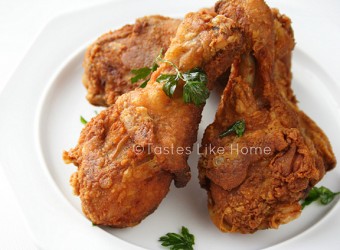Hi Everyone,
What is it about fried chicken that is so alluring? It’s a favourite of almost everyone, (well except vegetarians of course). There is something about it that is comforting and playful. Whenever fried chicken is around it always seems like a treat and a celebration.
With the proliferation of places to buy fried chicken, it is a dish that’s rarely made at home.
Frying chicken at home can be intimidating and confusing. Intimidating simply because the word ‘fry’ frightens a lot of people and not from the caloric content but rather the thought of working with hot oil. Overloaded with cooking information, we tend to think that special tools and equipment are needed, and finally, not knowing when the chicken is done cooking on the insides adds to the intimidation. Frying chicken becomes confusing when information is coming from all directions – brine, get buttermilk, coat in breakfast cereal for extra crunch, you’ve got to double-dip for a proper coating. Suddenly, we feel like homemade fried chicken is unattainable.

One of the many pleasures of eating fried chicken is that no cutlery is needed to eat the chicken – that is what makes it so playful. Can you see the platter or basket of chicken on the table begging to be eaten? Are you reaching for a piece? Everyone has his or her favourite pieces when it comes to fried chicken. For me, the drumsticks are the best, or the part that is known as the rib – that is a part of the backbone, wing and breast. That rib cut is the best meat to ratio piece of fried chicken. What’s your favourite piece of fried chicken?
Good fried chicken I believe comes from the seasoning of the meat and the technique involved in frying the chicken. Too often commercial fried chicken relies on the outer coating/breading to supply the flavour of the chicken, but the beauty of homemade fried chicken is that flavour is from the inside out. When it comes to the actual cooking of the chicken, you don’t need a deep fryer, karahi, wok or other type of deep frying pan, if you have a cast iron skillet, that is the cooking vessel of choice or if you have a similar heavy-bottomed pan that is at least 2 inches deep, that would work just fine. The technique I use is one which I saw my mother use when I was a kid. She’d add the chicken to the pan, cover the pan to steam-fry the chicken and then remove the lid to let it finish cooking and crisp up. Mommy’s fried chicken was always crisp on the outside, tender and juicy on the inside. When I read Norman King of Southern Living fame’s, “The Way To Fry”, and his instructions for making Southern fried chicken, I immediately wondered if my mother has some Southern blood in her. The method described in King’s book was the same as my mother’s – covering and uncovering the pan to trap the heat and steam cook the chicken and then releasing it to crisp the chicken.
Here are some general things to consider when frying chicken at home.

Let’s start with the chicken and seasoning. You don’t want an overly large chicken. A 3 to 4 pounder is ideal. If your chicken is 4 pounds, cut each side of the breast in half for even cooking. Cut the chicken into 8 – 10 pieces depending on the size (and this does not include the back of the chicken). A quality chicken needs nothing more than salt and pepper to season it but go ahead and add your favourite seasoning salt, green seasoning etc. and let the chicken marinate overnight in the refrigerator or at least 8 hours. It is important that you bring the chicken up to room temperature before cooking it. Adding cold chicken to hot oil will lower the temperature of the oil and cause the meat to spend more time in the oil than is necessary.
Oil & pan – use a neutral flavoured oil such as vegetable oil or canola oil. Peanut oil is the preferred oil of Southern cooks. Be mindful of the amount of oil suggested in recipes; bear in mind that the amount(s) suggested would be based upon the types of pans used to test the recipes. My advice is to use your eyes and trust your sense of cooking. When the chicken is added to the frying pan, the oil should come only halfway up the sides of the pan. In other words, the chicken is not completely covered in oil. As I suggested above, use a cast iron skillet or a frying pan that’s at least 2 inches deep.
Breading/coating – all you need is some good all-purpose flour. Add a little salt and ground black pepper to lightly season the flour. Dust the chicken in the flour and let it rest while the oil heat ups. The resting after dusting in flour ensures it adheres to the chicken for a crisp thin crust when cooked.
Cooking – add the oil to the pan after you have coated the chicken and let it get hot. The oil should be shimmering on the surface but not smoking. Medium heat is good and if you are using a heavy-bottomed pan it would conduct the heat evenly. If you have and are comfortable working with a thermometer, it should register 360 degrees. Chicken has dark and white meat. The dark meat would be the thighs, and drumsticks; the white meat would be the breast and wings. White meat always cooks up faster than dark meat so keep this in mind as you are frying. In other words, the breasts and wings will finish cooking faster than the thighs and drumsticks.
Depending on the size of your pan, you will need to work in batches. Add the chicken pieces skin-side down. Do not over crowd the pan or let the pieces touch each other. Cover the pan and cook for 6 minutes, uncover the pan and cook for 9 minutes. Turn the chicken pieces, cover and cook for 6 minutes. Uncover and cook for 5 to 9 minutes. All of these times would be dependent on the size of the chicken, the type of pan you use and the size of your burner. My chicken was fried in a regular cast iron skillet. When each piece of chicken comes out of the frying pan, drain it on paper towels.
Eating. Do not eat the chicken right away. Let the chicken rest for about 20 minutes, it needs time for the juices to be redistributed and the steam cooking inside of the chicken needs to complete its work. This resting time crisps up the outer coating.
Why not treat the family this weekend with some homemade fried chicken? Fry and let me know how it goes.
Cynthia





